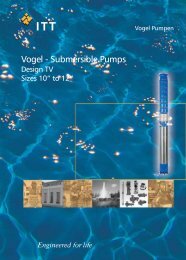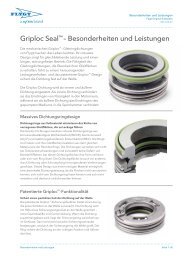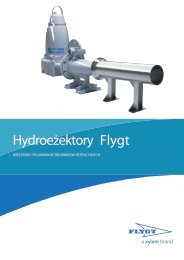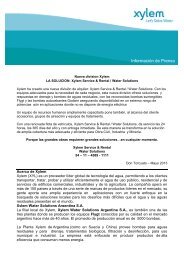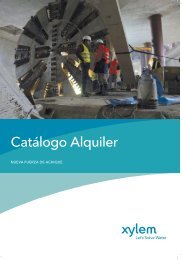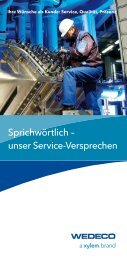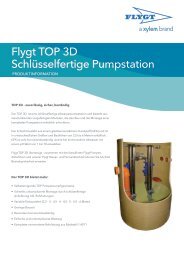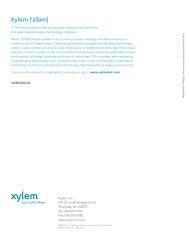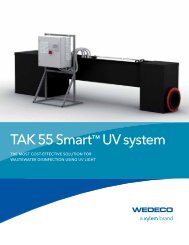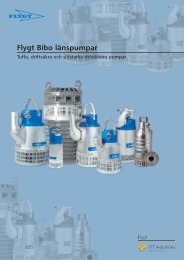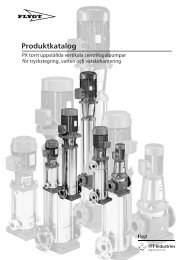Sanitaire, Silver Series - Water Solutions
Sanitaire, Silver Series - Water Solutions
Sanitaire, Silver Series - Water Solutions
You also want an ePaper? Increase the reach of your titles
YUMPU automatically turns print PDFs into web optimized ePapers that Google loves.
<strong>Sanitaire</strong>, <strong>Silver</strong> <strong>Series</strong>Installation,Operation, andMaintenance Manual
Table of ContentsTable of ContentsIntroduction and Safety.........................................................................................................................3Introduction..........................................................................................................................................3Other manuals...................................................................................................................................3Safety.....................................................................................................................................................3Safety terminology and symbols....................................................................................................4User safety.........................................................................................................................................5Environmental safety........................................................................................................................7Product warranty...............................................................................................................................7Transportation and Storage..................................................................................................................9Inspect the delivery.............................................................................................................................9Inspect the package.........................................................................................................................9Inspect the product..........................................................................................................................9Transportation guidelines..................................................................................................................9Precautions........................................................................................................................................9Lifting..................................................................................................................................................9Storage guidelines............................................................................................................................10Dry storage location.......................................................................................................................10System Description..............................................................................................................................12Diffusers included.............................................................................................................................12Diffuser design..................................................................................................................................12Intended use...................................................................................................................................12Definition of system components...................................................................................................12Installation.............................................................................................................................................14Precautions.........................................................................................................................................14Leveling guidelines........................................................................................................................14Dropleg and manifold installation..................................................................................................14Upper dropleg connection requirement....................................................................................15Support types..................................................................................................................................15Installation procedure overview...................................................................................................16Lay out the manifold centerline....................................................................................................16Lay out the manifold support locations.......................................................................................17Install the manifold anchors and supports .................................................................................18Assemble the manifold pipe sections..........................................................................................20Install the lower dropleg................................................................................................................22Air distributor installation.................................................................................................................24Lay out the air distributor support locations...............................................................................24Install the air distributor anchors and supports..........................................................................25Assemble an air distributor section.............................................................................................26Drainline installation.........................................................................................................................31Purge system installation..................................................................................................................31Install a manual purge system......................................................................................................31Install a continuous purge system................................................................................................32Diffuser installation...........................................................................................................................33Install the diffusers..........................................................................................................................33Plug blank holders..........................................................................................................................34Tank storage......................................................................................................................................34Store in tank when air and water is available..............................................................................35Store in tank without air, removed diffusers...............................................................................35Store in tank without air, with diffusers........................................................................................36<strong>Sanitaire</strong>, <strong>Silver</strong> <strong>Series</strong> Installation, Operation, and Maintenance Manual 1
Table of ContentsStore in tank with neither air nor water........................................................................................36Operation..............................................................................................................................................37Precautions.........................................................................................................................................37Start the system.................................................................................................................................37Maintenance.........................................................................................................................................40Precautions.........................................................................................................................................40Preventive maintenance...................................................................................................................40Purge the system............................................................................................................................40Air bumping....................................................................................................................................41Power failure and loss of air supply.............................................................................................41Visual inspection.............................................................................................................................41Recurrent maintenance....................................................................................................................41Maintenance schedule...................................................................................................................41Diffuser cleaning...............................................................................................................................41Clean the diffusers..........................................................................................................................41Manifold repair..................................................................................................................................42Replace a saddle............................................................................................................................42Repair a minor leak........................................................................................................................44Replace a cracked manifold pipe section...................................................................................44Align an air distributor connection..............................................................................................46Air distributor repair.........................................................................................................................47Replace an air distributor end......................................................................................................47Replace a spline coupling retainer ring.......................................................................................48Replace a holder.............................................................................................................................48Refit a holder...................................................................................................................................49Reroute an air distributor section.................................................................................................50Troubleshooting...................................................................................................................................51Operational troubleshooting...........................................................................................................51Diffuser fouling..................................................................................................................................51Technical Reference............................................................................................................................53Application limits...............................................................................................................................53Operational limits..............................................................................................................................53Performance curves..........................................................................................................................542 <strong>Sanitaire</strong>, <strong>Silver</strong> <strong>Series</strong> Installation, Operation, and Maintenance Manual
Introduction and SafetyIntroduction and SafetyIntroductionPurpose of this manualThe purpose of this manual is to provide necessary information for:• Installation• Operation• MaintenanceCAUTION:Read this manual carefully before installing and using the product. Improper use of theproduct can cause personal injury and damage to property, and may void the warranty.NOTICE:Save this manual for future reference, and keep it readily available at the location of theunit.Other manualsSee also the safety requirements and information in the original manufacturer's manualsfor any other equipment furnished separately for use in this system.SafetyDANGER:• Operating, installing, or maintaining the unit in any way that is not covered in this manualcould cause death, serious personal injury, or damage to the equipment. This includesany modification to the equipment or use of parts not provided by Xylem. If there is aquestion regarding the intended use of the equipment, please contact a Xylemrepresentative before proceeding.• Do not change the service application without the approval of an authorized Xylemrepresentative.CAUTION:• The operator must be aware of safety precautions to prevent physical injury.• Read this manual carefully before installing and using the product. Improper use of theproduct can cause personal injury and damage to property, and may void the warranty.You must observe the instructions contained in this manual. Failure to do so could result inphysical injury, damage, or delays.The safety information presented here is organized into the following areas:• An explanation of safety symbols and hazard levels, see Safety terminology andsymbols (page 4)• Safety precautions to prevent physical injury to personnel, see User safety (page 5)• Precautions for protecting the environment, see Environmental safety (page 7)<strong>Sanitaire</strong>, <strong>Silver</strong> <strong>Series</strong> Installation, Operation, and Maintenance Manual 3
Introduction and SafetySafety terminology and symbolsAbout safety messagesIt is extremely important that you read, understand, and follow the safety messages andregulations carefully before handling the product. They are published to help preventthese hazards:• Personal accidents and health problems• Damage to the product• Product malfunctionHazard levelsHazard levelIndicationDANGER:A hazardous situation which, if not avoided, will result indeath or serious injuryWARNING:A hazardous situation which, if not avoided, could resultin death or serious injuryCAUTION:A hazardous situation which, if not avoided, could resultin minor or moderate injuryNOTICE:• A potential situation which, if not avoided, couldresult in undesirable conditions• A practice not related to personal injuryHazard categoriesHazard categories can either fall under hazard levels or let specific symbols replace theordinary hazard level symbols.Electrical hazards are indicated by the following specific symbol:Electrical Hazard:These are examples of other categories that can occur. They fall under the ordinary hazardlevels and may use complementing symbols:• Crush hazard• Cutting hazard• Arc flash hazard4 <strong>Sanitaire</strong>, <strong>Silver</strong> <strong>Series</strong> Installation, Operation, and Maintenance Manual
Introduction and SafetyUser safetyGeneral safety rulesThese safety rules apply:• Machinery in the work area must be de-energized (lockout/tagout) before startingwork.• Pay attention to the risks presented by gases and vapors in the work area.• Always bear in mind the risk of drowning, electrical dangers, and burn injuries.Safety equipmentUse personal protective equipment in accordance with applicable laws, regulations, andguidelines.Personal protective equipment which may be required includes:• Hard hat• Safety goggles, preferably with side shields• Protective shoes• Protective gloves• Breathing apparatus• Hearing protection• First-aid kit• Safety devicesNOTICE:Never operate a unit unless safety devices are installed. Also see specific informationabout safety devices in other chapters of this manual.Electrical connectionsElectrical connections must be made by certified electricians in compliance with allapplicable codes and regulations. For more information about requirements, see sectionsdealing specifically with electrical connections.Confined spacesTo ensure your own safety when working in a confined space, follow this procedure.DANGER:Before entering the work area, make sure that the atmosphere contains sufficient oxygenand no toxic gases.WARNING:The chamber or tank where the equipment is installed should be treated as a confinedspace. Always follow the applicable safety laws, regulations and guidelines for enclosedspaces.Never work alone in a confined space. Before entering the space, check that the followingrequirements are complied with:• The atmosphere contains sufficient oxygen• The atmosphere contains no explosive or toxic gases• All energy sources are locked out and tagged out• Adequate ventilation is in place• There is a clear path of retreat• Monitoring is in place for hazards which can develop after entering the confined space<strong>Sanitaire</strong>, <strong>Silver</strong> <strong>Series</strong> Installation, Operation, and Maintenance Manual 5
Introduction and SafetyDrowningSpaces that are not fully drained or dry can pose a risk of drowning. It takes relatively littlestanding water or other liquid to create a drowning hazard. For example, insufficientoxygen or the presence of a toxic material can make a worker unconscious, which makesthem vulnerable to drowning if they fall face down into a small pool of water. Never workalone where there is a risk of drowning.WARNING:Always bear in mind the risk of drowning.Biological hazardsThe product is designed for use in liquids that can be hazardous to your health. Observethese rules when you work with the product:• Make sure that all personnel who may come into contact with biological hazards arevaccinated against diseases to which they may be exposed.• Observe strict personal cleanliness.WARNING:Rinse the unit thoroughly with clean water before working on the unit.Organic dustWARNING:• Rinse the components in water after dismantling.• Rinse the unit thoroughly with clean water before working on the unit.Working with solventsWhen performing maintenance on the product inside or close to the tank or pit where theproduct is used, workers may be exposed to organic dust contaminated withmicroorganisms.Employers and workers can minimize the risks of exposure to organic dust by taking thefollowing precautions:• Be aware of the adverse health effects of breathing organic dust.• Use engineering controls such as local exhaust ventilation, and wet methods of dustsuppression to minimize exposure to organic dust.• Use appropriate respirators when exposure to organic dust cannot be avoided.• Follow all health and safety rules and local codes and ordinances.WARNING:Potential fire and explosion hazard: Before working in this area, clear all dust andflammable material from the work area and provide sufficient ventilation.CAUTION:These chemicals can cause physical injury. Contact the supplier for information and advicefor proper handling precautions and procedures.Be aware of changing conditions when using solvents. Follow all health and safety rulesand local codes and ordinances.6 <strong>Sanitaire</strong>, <strong>Silver</strong> <strong>Series</strong> Installation, Operation, and Maintenance Manual
Introduction and SafetyWash the skin and eyesFollow these procedures for chemicals or hazardous fluids that have come into contactwith your eyes or your skin:ConditionChemicals or hazardousfluids in eyesChemicals or hazardousfluids on skinAction1. Hold your eyelids apart forcibly with your fingers.2. Rinse the eyes with eyewash or running water for at least 15 minutes.3. Seek medical attention.1. Remove contaminated clothing.2. Wash the skin with soap and water for at least 1 minute.3. Seek medical attention, if necessary.Environmental safetyThe work areaAlways keep the station clean to avoid discharge or release of environmentally hazardoussubstances, and to aid in detecting inadvertent discharges.Waste and emissions regulationsObserve these safety regulations regarding waste disposal and release of substances:• Appropriately dispose of all waste.• Handle and dispose of used or process liquids in compliance with applicableenvironmental regulations.• Clean up all spills in accordance with safety and environmental procedures.• Report all environmental discharges to the appropriate authorities.WARNING:Do NOT send the product to the Xylem manufacturer if it has been contaminated by anynuclear radiation. Inform Xylem so that accurate actions can take place.Recycling guidelinesProduct warrantyAlways follow local laws and regulations regarding recycling.CoverageLimitationsXylem undertakes to remedy faults in all equipment supplied under these conditions:• The faults are due to defects in design, materials, or workmanship.• The faults are reported to a Xylem representative within the warranty period.• The product is used only under the conditions described in this manual.• All service and repair work is done according to the instructions in this manual.• Genuine parts from the original equipment manufacturers are used.Replacement does not include labor for removal or re-installation of the unit or partsdeemed defective.The warranty does not cover faults caused by these situations:• Deficient maintenance• Improper installation• Modifications or changes to the product and installation made without consultingXylem<strong>Sanitaire</strong>, <strong>Silver</strong> <strong>Series</strong> Installation, Operation, and Maintenance Manual 7
Introduction and Safety• Incorrectly executed repair work• Normal wear and tearXylem assumes no liability for these situations:• Bodily injuries• Material damages• Economic lossesWarranty claimSpare partsXylem products are high-quality products with expected reliable operation and long life.However, should the need arise for a warranty claim, then contact your Xylemrepresentative.Xylem guarantees that spare parts will be available for 10 years after the manufacture ofthis product has been discontinued.8 <strong>Sanitaire</strong>, <strong>Silver</strong> <strong>Series</strong> Installation, Operation, and Maintenance Manual
Transportation and StorageTransportation and StorageInspect the deliveryInspect the packageInspect the product1. Inspect the package for damaged or missing items upon delivery.2. Note any damaged or missing items on the receipt and freight bill.3. File a claim with the shipping company if anything is out of order.If the product has been picked up at a distributor, make a claim directly to thedistributor.1. Inspect the product to determine if any parts have been damaged or are missing.2. If applicable, unfasten the product by removing any screws, bolts, or straps.For your personal safety, be careful when you handle nails and straps.3. Contact your sales representative if anything is out of order.Transportation guidelinesPrecautionsWARNING:• Stay clear of suspended loads.• Observe accident prevention regulations in force.LiftingLifting equipment is always required when handling the shipment. The equipmentcomponents can be lifted with either a crane or a forklift.WARNING:• Crush hazard. The unit and the components can be heavy. Use proper lifting methodsand wear steel-toed shoes at all times.NOTICE:• Lift and handle the product carefully, using suitable lifting equipment.• The product must be securely harnessed for lifting and handling. Use eyebolts orlifting lugs if available.Lifting with craneCranes used to lift the equipment components must fulfill the following requirements:• The lifting equipment must be able to hoist the equipment components straight upand down, preferably without the need for resetting the lifting hook.• The lifting strap must be fastened to the lifting points on top of the package.<strong>Sanitaire</strong>, <strong>Silver</strong> <strong>Series</strong> Installation, Operation, and Maintenance Manual 9
Transportation and Storage2311. Lifting point2. Minimum 2 m (6 ft 7 in.)3. Lifting deviceFigure 1: Lifting points1. Check that the site where the equipment components will be placed has a clean andlevel surface.2. Fasten a suitable lifting strap or sling to the lifting points on top of the pallet, if used.3. If the equipment components are secured to the flatbed or other surface, then cut thetransportation straps.4. Lift using proper lifting equipment.5. Place the equipment components on a clean, rigid, horizontal surface so that theycannot fall over.WS000152BLifting with pallet and forkliftWS003729A1. Align the forklift prongs with the forklift hole(s), and insert the prongs.2. If the pallet is secured to the flatbed or other surface, then cut the transportationstraps.3. Lift the pallet and move it to its new position.4. Place the pallet on a clean, rigid, horizontal surface so that it cannot fall over.Storage guidelinesDry storage locationThe storage site must be available before equipment arrival. The product must be storedin a level, covered, and dry location free from heat, dirt, and vibrations. The diffusers mustbe kept in the original packaging until the final installation unless they are pre-mounted onthe pipe.10 <strong>Sanitaire</strong>, <strong>Silver</strong> <strong>Series</strong> Installation, Operation, and Maintenance Manual
Transportation and StorageNOTICE:• Do not stack shipping units.• Do not place heavy weights on the packed product.• Protect the product against humidity, heat sources, and mechanical damage.• Do not cover the pipe components with plastic. Excessive heat build-up can damageplastic pipes and void the warranty.• Risk of wear. Make sure the equipment is clean before it is placed into service.<strong>Sanitaire</strong>, <strong>Silver</strong> <strong>Series</strong> Installation, Operation, and Maintenance Manual 11
System DescriptionSystem DescriptionDiffusers includedTypeFine bubbleModel<strong>Silver</strong> <strong>Series</strong> II LP, 9 in.<strong>Silver</strong> <strong>Series</strong> II, 7 and 9 in.Diffuser designFine bubble disc diffusers are designed for an efficient and reliable aeration and mixingprocess of industrial and municipal wastewater. The fine bubble diffuser is completelycompatible with other <strong>Sanitaire</strong> aeration equipment.Intended useThe product is only for use with municipal and industrial wastewater. Always follow thelimits given in Application limits (page 53). If there is a question regarding the intendeduse of the equipment, please contact a sales representative before proceeding.Definition of system componentsThe main components in an aeration system are shown in the figure below.3247516WS003581APositionnumberDescriptionDefinition1 Blower The device that distributes the air to the air main.2 Air main The pipe that connects the blower to the upper dropleg.3 Upper dropleg The pipe that connects the air main to the lower dropleg.4 Lower dropleg The pipe that connects the upper dropleg to the manifold.5 Manifold The pipe that connects the lower dropleg to the air distributor. There are no holdersmounted on this pipe.12 <strong>Sanitaire</strong>, <strong>Silver</strong> <strong>Series</strong> Installation, Operation, and Maintenance Manual
3. Häufig gestellte FragenSonstiges• Ausgabenerstattungsprinzip• Projektkonto• kein eigenes Bankkonto erforderlichz.B. auch SAP-Konto• Zweckbindungsfristen• i.d.R. 5 Jahre nach Projektdurchführung• Vorsteuerabzugsberechtigung• Bruttobeträge bei Hochschulen15Mai 2009 Die Rolle der NRW.BANK im Wettbewerbsverfahren - Hannelore Scho-in het VeldFinanzierungsberatung und Zuschussbewilligung
InstallationInstallationPrecautionsWARNING:Always follow safety guidelines when working on the product. See Introduction and Safety(page 3).RequirementsThe following requirements apply:• Never work alone.• Make sure to have a clear path of retreat.• Make sure that the work area is properly ventilated.• Provide a suitable barrier around the work area, for example a guard rail.• Check the explosion risk before you weld or use electrical hand tools.• Ensure that welding or construction work does not damage the aeration systemequipment.• Use the installation drawings, containing the required part number designation, inorder to ensure proper installation.• Remove all debris from the air main before installation.The figures in the instructions can differ from the delivered products.Leveling guidelinesTo ensure an installation where maximum system efficiency is obtained, and where leaks,adjustments, and damage to products are minimized, follow these guidelines:• Always use the highest point of the tank floor as a reference when leveling. The heightof the grid should be as low as possible at this point.• Use a level system which ensures installation within the given tolerance (6 mm [¼ in.]horizontally).• Allow for movement of the pipes when securing the clamps.• Align pipes correctly before couplings are assembled.Dropleg and manifold installationPrerequisites• Always use the highest point of the tank floor as a reference when leveling.• Ensure that the air filtration equipment is installed and operating.• Ensure that all dirt and debris are removed from the air main.If air blowers are used, then follow the instructions from the manufacturer. Blowers canrequire a minimum back pressure when operating.14 <strong>Sanitaire</strong>, <strong>Silver</strong> <strong>Series</strong> Installation, Operation, and Maintenance Manual
InstallationFigure 5: Support without strutWS000155AWS000156AFigure 6: Support with strutInstallation procedure overviewWS003553ALay out the manifold centerlineThe manifold installation includes the following steps:• Lay out the manifold centerline (page 16)• Lay out the manifold support locations (page 17)• Install the manifold anchors and supports (page 18)• Assemble the manifold pipe sections (page 20)• Install the lower dropleg (page 22)The dropleg connection to the manifold is located directly under the dropleg. In someinstallations, the dropleg connection is offset.16 <strong>Sanitaire</strong>, <strong>Silver</strong> <strong>Series</strong> Installation, Operation, and Maintenance Manual
Installation1. In-line manifold2. Offset manifold12WS003554B1. Locate the centerline of the manifold.Use the installed upper dropleg and the installation drawings.2. Mark clearly the position on the floor.Lay out the manifold support locationsWS003555A<strong>Sanitaire</strong>, <strong>Silver</strong> <strong>Series</strong> Installation, Operation, and Maintenance Manual 17
Installation1. Locate and layout all manifold support locations.Use the installation drawings and shippings lists.2. Mark clearly the positions on the floor.Install the manifold anchors and supportsThe manifold sections must be placed according to the manifold and anchor layout beforethe anchors are installed.Always use the highest point of the tank floor as a reference when leveling.1. Lower the manifold sections into the tank.2. Place the sections according to the layout and double check for possible interference.Use the reference numbers from the installation drawings to identify the pipe sections.3. Check, and if necessary, correct the positions of the support anchors.Consider the offset from the anchor position to the center line of the support, andinstall all supports in the same direction.Ensure that the maximum support spacing does not exceed 2400 mm or 8 ft.WS003556B4. Install the manifold support anchors according to the instructions from themanufacturer.The threaded projection from the floor level must correspond to the installationdrawing anchor table.18 <strong>Sanitaire</strong>, <strong>Silver</strong> <strong>Series</strong> Installation, Operation, and Maintenance Manual
InstallationWS003548BThe tightening torque values are listed in the installation instructions from the anchorbolt manufacturer.5. On a single anchor support, install the locating plate with the two bent prongs in front,inside the support rod, and the single prong to the back, inside the u-bend.Install all supports in the same direction.123458761. Hexagon nut2. Flat washer3. Locating plate4. Back of support5. Support rod6. Inside of support rod7. Anchor bolt8. Front of support rodWS000180AWS003559A6. Install the struts, if applicable.7. Install the hexagon nuts and place the lower pipe support clamp on them.<strong>Sanitaire</strong>, <strong>Silver</strong> <strong>Series</strong> Installation, Operation, and Maintenance Manual 19
Installation45678121. Hexagon nut2. Strut3. Anchor bolt4. Clamp5. Washer6. Hexagon nut7. Rod8. Anchor bolt9. Hexagon nut10. Washer, round11. Washer, square91011CL3WS000157C8. Use the installation drawings and a level system to find the correct clamp flangeelevation.Assemble the manifold pipe sectionsThe correct elevation is equal to the manifold center line, and the tolerance is ± 6 mm(¼ in.).CAUTION:These chemicals can cause physical injury. Contact the supplier for information and advicefor proper handling precautions and procedures.1. Examine the manifold sections.If the sections are dirty and contain debris from storage, then flush with water beforeinstallation.2. Remove all protective dust covers from the pipe ends and connections.3. Place the manifold sections in the lower part of the support clamp.20 <strong>Sanitaire</strong>, <strong>Silver</strong> <strong>Series</strong> Installation, Operation, and Maintenance Manual
InstallationWS003557A4. Connect the manifolds:a) Connect flanges with bolts loosely.b) Connect joints with glue.c) Connect spline couplings without tightening.5. Install the upper part of the support clamp with washers and nuts.Tighten loosely.6. Level the manifold sections which attach to the droplegs.• For in-line manifolds, ensure that the air distributor connections are horizontal.• For raised manifolds, ensure that the air distributor connections are vertical.WS000161AWS000162AFigure 7: In-line manifoldFigure 8: Raised manifold7. Secure the clamps on the sections which attach to the droplegs by tightening thehexagon nuts.Ensure that the manifold is horizontal.8. Install all manifold sections according to the installation drawings.Do not secure the clamps on these sections at this point.9. Install the lower dropleg according to Install the lower dropleg (page 22).10. Complete the manifold installation:<strong>Sanitaire</strong>, <strong>Silver</strong> <strong>Series</strong> Installation, Operation, and Maintenance Manual 21
InstallationInstall the lower droplega) Level the remaining manifold sections and ensure that the air distributorconnections are level.b) Tighten the flange connections between the manifold sections.c) Secure the pipes by tightening the hexagon nuts on the upper part of the clamps.CAUTION:These chemicals can cause physical injury. Contact the supplier for information and advicefor proper handling precautions and procedures.An in-line manifold (see figure below) does not require a feed pipe. See the installationdrawings.1. Install the feed pipe and support, if applicable. This is only applicable to an offsetmanifold.a) Glue the feed pipe and fittings.b) Install the feed pipe and the supports, if applicable.211. Upper dropleg2. Lower dropleg, cut to length X3. Socket fitting4. Upper dropleg centerline5. Feed pipe centerline3X≤ 3 mm (1/8 in.)54WS000163CFigure 9: Parts between dropleg andmanifold, offset manifold2. Measure the distance X from the end of the installed upper dropleg to the insertiondepth of the socket fitting.If a flange connection is used, then consider the flange, the socket depth, and thegasket thickness.3. Remove the upper dropleg out of the work area.4. Cut or trim the lower dropleg to the measured distance.5. Glue the lower dropleg into the socket fitting.6. Reinstall the upper dropleg.Ensure that the gap between the upper and lower dropleg is maximum 3 mm (1/8 in.).22 <strong>Sanitaire</strong>, <strong>Silver</strong> <strong>Series</strong> Installation, Operation, and Maintenance Manual
InstallationWS000164B≤ 3 mm (1/8 in.)Figure 10: Upper and lower dropleg7. Install the clamp coupling or tighten the flange connection.Tighten the clamp coupling bolts to a torque of 70–75 Nm (50–55 ft-lbs).WS000166AWS000165AFigure 11: Example of clamp couplingFigure 12: Example of flange connection8. Tighten the upper dropleg to the air main.9. Complete the manifold installation according to the last step in Assemble the manifoldpipe sections (page 20).<strong>Sanitaire</strong>, <strong>Silver</strong> <strong>Series</strong> Installation, Operation, and Maintenance Manual 23
InstallationAir distributor installationInstallation procedure overviewWS003551AThe installation includes the following steps:• Lay out the air distributor support locations (page 24)• Install the air distributor anchors and supports (page 25)• Assemble an air distributor section (page 26)• Place the sections (page 27)• Assemble with spline couplings (page 28)• Assemble with expansion couplings (page 28)• Leval and tighten the air distributors (page 30)For drainline installation, see Drainline installation (page 31).Lay out the air distributor support locations1. Lay out the centerline for each air distributor.Use the installation drawings and the manifold air distributor connections. Startmeasuring from the center line of the manifold.2. Mark the air distributor support locations for the first air distributor from one side. See(1) in the figure below.The distance between the manifold center line and first support location is marked X inthe figure below. The distance to the second support location is marked Y.24 <strong>Sanitaire</strong>, <strong>Silver</strong> <strong>Series</strong> Installation, Operation, and Maintenance Manual
Installation221X1YWS003558B3. Ensure that there is no interference between the holders, couplings, and supports.4. Make the required adjustments.If spacing is extended beyond the installation drawing specification, then consult yourXylem representative.5. Mark the support locations for the air distributor located at the opposite end of themanifold. See (2) in the figure above.6. Use a chalk line to mark all support locations between the outside layout lines.Install the air distributor anchors and supportsSloped floors can require the use of several different support types or support roddiameters. Refer to the installation drawings for identification of the correct support at eachlocation.1. Install the anchor bolts according to the instructions from the manufacturer.The threaded projection from the floor level must correspond to the installationdrawing anchor table.<strong>Sanitaire</strong>, <strong>Silver</strong> <strong>Series</strong> Installation, Operation, and Maintenance Manual 25
InstallationWS003548B2. Install the locating plate with the two bent prongs in front, inside the support rod, andthe single prong to the back, inside the u-bend.Install all supports in the same direction.123458761. Hexagon nut2. Flat washer3. Locating plate4. Back of support5. Support rod6. Inside of support rod7. Anchor bolt8. Front of supportWS000180AWS003559A3. Tighten the hexagon nut to the recommended torque value as listed by the anchorbolt manufacturer.4. Using a level system, find the correct elevation to put the hexagon nut on all airdistributor supports.The correct elevation is the air distributor center line, shown on the installationdrawings. The difference in height can not exceed a tolerance of ± 6 mm (¼ in.) fromone side to the other throughout the whole grid.5. Install the lower clamp sections on all air distributor supports.Assemble an air distributor sectionThis instruction describes the assembly of a complete air distributor section from themanifold to the end cap.Use the following:• Air distributor sections, see the installation drawings and the corresponding markingson the sections• Spline couplings26 <strong>Sanitaire</strong>, <strong>Silver</strong> <strong>Series</strong> Installation, Operation, and Maintenance Manual
Installation• Expansion couplings, if applicable• Drainline sections, if applicableWS000170AFigure 13: Markings on installation drawings and sectionsPlace the sectionsWS003560A1. Starting from the manifold, check and flush out any dirt from the first section and placeit in the supports.2. Assemble the first section according to the instructions in Assemble with splinecouplings (page 28).3. Check and flush out any dirt from the subsequent section and assemble according tothe instructions in Assemble with spline couplings (page 28) or Assemble withexpansion couplings (page 28). Repeat this step until all the sections have beenassembled.4. Install the end caps according to the instructions in Install the end cap (page 29).<strong>Sanitaire</strong>, <strong>Silver</strong> <strong>Series</strong> Installation, Operation, and Maintenance Manual 27
InstallationAssemble with spline couplingsBefore starting the assembly, ensure that the air distributor sections are as level aspossible.The spline coupling is a coupling that is used to prevent an air distributor section fromrotating.To adjust the spline coupling after the initial installation, it must be loosened and backedoff until the splines are disengaged.1. Spline socket2. O-ring3. Spline spigot4. Retainer ringWS003626AFigure 14: Spline couplingAssemble with expansion couplings1. Lubricate the O-ring for ease of installation.Use a common dish soap solution. Do not use oil or grease.2. Fit the O-ring into the spline socket.3. Push the spline spigot into the spline socket.Ensure that the splines are fully engaged.4. Thread the retainer ring onto the spline socket.5. Tighten the retainer ring to a hand-tight position.Do not use a spanner wrench or other tool to tighten the retainer ring. The spannerwrench sent together with spares is used for disassembly only.Expansion couplings are used in some installations and always together with fixedsupports.1. Spline socket2. O-ring3. Retainer ring4. Spline spigot5. Retainer ring6. O-ringWS003627AFigure 15: Expansion coupling28 <strong>Sanitaire</strong>, <strong>Silver</strong> <strong>Series</strong> Installation, Operation, and Maintenance Manual
Installation1. Assemble the coupling:1. Spline spigot end placement in anassembled coupling2. O-ring placementWS003641Aa) Fit both retainer rings on the spline spigot.b) Lubricate the O-ring for ease of installation.Use a common dish soap solution. Do not use oil or grease.c) Fit the O-ring on the spline spigot.Place the O-ring at half the length of the spline spigot, which is 60 mm (2 3/8 in.)from the end.d) Push the spline socket onto the spline spigot.See the exploded view for spline spigot end placement in the spline socket.e) Thread the retainer ring onto the spline socket, until the O-ring seats.f) Tighten the retainer ring to a hand-tight position.2. Install the assembled coupling:1. Spline socketWS003642Aa) Lubricate the O-ring for ease of installation.Use a common dish soap solution. Do not use oil or grease.b) Fit the O-ring into the spline socket.c) Push the assembled coupling into the spline socket.d) Thread the retainer ring onto the spline socket.e) Tighten the retainer ring to a hand-tight position.Install the end capThe end cap is in some cases factory assembled with the air distributor.<strong>Sanitaire</strong>, <strong>Silver</strong> <strong>Series</strong> Installation, Operation, and Maintenance Manual 29
Installation2341. Spline socket2. O-ring3. End cap4. Retainer ring1WS003628ALeval and tighten the air distributors1. Lubricate the O-ring for ease of installation.Use a common dish soap solution. Do not use oil or grease.2. Fit the O-ring into the spline socket.3. Push the end cap into the spline socket.4. Thread the retainer ring onto the spline socket.5. Tighten the retainer ring to a hand-tight position.1. Install the top half clamp on each support, and loosely install the top hexagon nuts.WS003562A2. Rotate the distributor section until the diffuser is level.Use a level system. Make sure to disengage the splines before rotating.3. Hold the pipe section level and do one or both of the following:a) Retighten all corrected spline couplings.b) If expansions couplings are used, then tighten all fixed support clamps on thosesections.4. Recheck for level both perpendicular and parallel to the distributor section.5. Continue this procedure for all distributor sections.6. Tighten all nuts on the supports.NOTICE:The clamps must be loose around the pipe to allow for movement. Do not wrapanything around the pipe to tighten the clamps against the pipe.30 <strong>Sanitaire</strong>, <strong>Silver</strong> <strong>Series</strong> Installation, Operation, and Maintenance Manual
InstallationWS000186ADrainline installationSeparate drainlines are primarily used on fine bubble systems with raised manifolds. Onsystems with in-line manifolds, the manifold normally serves as drainline.Ensure that the installation of the drainline is made according to the installation drawings.123WS000168B1. Raised manifold2. Air distributor3. DrainlineFigure 16: Raised manifold with drainlinePurge system installationInstall a manual purge systemThere are two types of purge systems:• The manual purge system, with sump and evacuation pipeThis system uses a sump with an eductor line that extends from the grid to above thewater surface and ends with a manual ball valve.• The continuous purge system, with a diffuser unit that is attached to the bottom of themanifold or the drainlineThe entrapped moisture is continuously purged from the system.The manual purge system consists of a sump and an evacuation pipe.<strong>Sanitaire</strong>, <strong>Silver</strong> <strong>Series</strong> Installation, Operation, and Maintenance Manual 31
Installation1. Suction tube2. Air orifice hole3. Evacuation pipe321WS000196BThe sump for systems using in-line manifolds is builtinto the manifold pipe.The sump for systems using the raised manifold isinstalled between air distributor or drainline sections.Figure 17: Sump in in-line manifoldWS000187AFigure 18: Sump between air distributorsectionsWS000188A1. Identify the parts of the purge system.2. Install the purge system according to the installation drawings.Install a continuous purge systemThe continuous purge system consists of a diffuser unit that is attached to the bottom ofthe manifold, air distributor, or drainline.121. Hose2. Tube diffuser3. Support4. Cap with drainline tap43WS000189CFigure 19: Continuous purgeThe installation is made according to the installation drawings.1. Assemble the continuous purge.2. Install the supports on the tank floor according to the installation drawings and theinstructions from the anchor bolt manufacturer.Ensure that the tube diffuser is placed horizontally, aligned with the orifice and at anelevation lower than the section to which it is attached.3. Cut the hose to the correct length.4. Attach the hose to the cap with drainline tap.32 <strong>Sanitaire</strong>, <strong>Silver</strong> <strong>Series</strong> Installation, Operation, and Maintenance Manual
Diffuser installationPrerequisitesInstall the diffusersMake sure that the manifold, air distributor, or drainline is tapped at a low point.The diffusers should be installed just before the scheduled start-up of the aeration system.If the diffusers are pre-mounted, then ensure that all retainer rings are in a hand-tightposition. If not, tighten according to the applicable steps in Install the diffusers (page 33).If the diffusers are not delivered pre-mounted, they must be assembled. Before theassembly, ensure that:Installation• The holders are clean.• The orifices are not obstructed.• Blank holders are plugged according to the instructions in Plug blank holders (page34). See the installation drawings for the location of blank holders.The orifices must be drilled with the correct tool if they are obstructed. Contact your localsales representative.121. Retainer ring2. Diffuser3. Support plate4. Orifice5. Holder6. Air distributor pipe7. Spanner wrench34756Figure 20: Exploded viewWS000194D1. Set the support plate, if applicable, in the holder with the flat side up.WS000193A2. Mount the diffuser.The thicker circumference of the diffuser must fit down into the void at the edge of theholder to ensure good sealing.<strong>Sanitaire</strong>, <strong>Silver</strong> <strong>Series</strong> Installation, Operation, and Maintenance Manual 33
Installation11. Retainer ring2. Diffuser3. Support plate4. Holder243WS003546APlug blank holdersFigure 21: Diffuser placement3. Lubricate the retainer ring with a small amount of the lubricant provided.Only lubricate at position 1 in the figure above. Avoid getting lubricant on the threads.4. Turn the retainer ring to a hand-tight position.5. Turn the retainer ring an additional 30°, using the spanner wrench.Do not exceed 90°.A holder that is not put into operation must be plugged. This procedure is called to leave itblank. If the aeration process requirements change, then the holder can be put intooperation later.1. Locate blank holder positions. See the installation drawings.2. To ensure proper embedment, add the provided lubricant in the plugging tool beforeinserting the plug.3. Plug the orifice.231. Orifice2. Tool3. Plug4. Holder5. Air distributor415Figure 22: Example of plugging toolWS000195ATank storageThe different options have been developed to protect the pipes and diffusers fromenvironmental damage, and are listed in order of preference.34 <strong>Sanitaire</strong>, <strong>Silver</strong> <strong>Series</strong> Installation, Operation, and Maintenance Manual
InstallationXylem assumes no responsibility for damage and cleaning requirements as a result oflong-term storage. See Application limits (page 53) for temperature limitations.• Equipment flooded by overflows, misdirected sewage flows, and excessive airbornedirt build-up require cleaning before being placed in service.• Standing water which is allowed to freeze around the pipe can break the pipe or causediffusers to crack.• UV light degradation and heat build-up in the tank bottom can cause warping and lossof some structural properties.NOTICE:Risk of wear. Make sure the equipment is clean before it is placed into service.Store in tank when air and water is availableThis procedure describes storage of an installed system, before taking it into operation.1. Add protection around the dropleg and the carrier columns in the tank when there is arisk of ice build-up.Use for example Styrofoam blocks.2. Fill the tank with clean water to a minimum level of 1 m (3.1 ft) above the lowerdroplog. This action gives the pipe and the diffusers protection from UV light and heatbuild-up.3. Run a small amount of air through the system to secure that the pipes remain free fromwater and to minimize the growth of algae on the diffusers.4. Take appropriate measures against excessive algae growth.5. Before bringing the system into operation:a) Drain and check all hardware.b) Check the diffusers and clean if fouling is evident.The operator may have to adjust the air flow rate to a higher level to prevent ice formationduring severely cold temperatures.Store in tank without air, removed diffusersThis procedure describes storage of an installed system in a flooded tank, before taking itinto operation.1. If there is a risk of ice build up, then start by installing styrofoam blocks around thedropleg and carrier columns installed in the tank.If ice builds up around the pipes, these blocks prevent crushing.2. Remove all diffusers, O-rings, retainer rings, support plates, and so on.3. Clean as required, and store in a clean, dry environment.4. Fill the tank with clean water to a minumum level of 1 m (3.1 ft) above the lowerdropleg.5. Take appropriate measures against excessive algae growth.6. Before bringing the system into operation:a) Ensure that there is no ice in the tank.b) Drain and check all hardware.c) Check all holders.d) Spot check pipe internals for algae growth and fouling.e) Clean as required before installing the diffusers.NOTICE:Falling ice can crush the system. If water freezes, do not drain the water below the ice layer.<strong>Sanitaire</strong>, <strong>Silver</strong> <strong>Series</strong> Installation, Operation, and Maintenance Manual 35
InstallationStore in tank without air, with diffusersThis procedure applies to storing in a flooded tank with diffusers installed.1. If there is a risk of ice build up, then start by installing styrofoam blocks around thedropleg and carrier columns installed in the tank.If ice builds up around the pipes, these blocks prevent crushing.2. Fill the tank with clean water to a minumum level of 1 m (3.1 ft) above the lowerdropleg.3. Take appropriate measures against excessive algae growth.4. Before bringing the system into operation:a) Ensure that there is no ice in the tank.b) Drain and check all hardware.c) Spot check pipe internals for algae growth and fouling.d) Remove the diffusers and spot check the underside to determine the extent offouling, and if cleaning is required before use.e) Clean as required before use and then remount the diffusers.NOTICE:Falling ice can crush the system. If water freezes, do not drain the water below the ice layer.Store in tank with neither air nor waterThis procedure applies to storing in tanks when flooding is undesirable.1. Drain tanks dry.2. Clean out solids and debris.3. Make sure that floor drains remain open to prevent water from standing in the pipesystem and tank.4. Before bringing the system into operation:a) Check gaskets and O-rings for deterioration or leakage.b) Replace as required.• Equipment flooded by overflows, misdirected sewage flows, and excessive airbornedirt build-up require cleaning before being placed in service.• Standing water which is allowed to freeze around the pipe can break the pipe or causediffusers to crack.NOTICE:Risk of wear. Make sure the equipment is clean before it is placed into service.36 <strong>Sanitaire</strong>, <strong>Silver</strong> <strong>Series</strong> Installation, Operation, and Maintenance Manual
OperationOperationPrecautionsWARNING:Always follow safety guidelines when working on the product. See Introduction and Safety(page 3).• Never work alone.• Make sure that you have a clear path of retreat.• Never operate the system without safety devices installed.• Make sure that all safety guards are in place and secure.PreconditionsPerform a final tank inspection:• Tighten any loose nuts, joints, or end caps• Replace any missing or improperly placed hardware.Before starting the system, ensure that all repair work is completed. Before doing anywork, see Introduction and Safety (page 3).Start the systemComplete the start-up procedure before the site visit by authorized service personnel.WARNING:• Slips and falls can cause severe injuries.• Bear in mind the risk of drowning.NOTICE:To avoid damage to the piping, introduce water to the tank at a low flow rate and avoidvertical water flow falling directly on the piping.1. Start filling the aeration tank with clean water.2. If a manual purge system is installed, then disconnect the purge hoses from the sumps.3. When the water level reaches a point just above the top of the air distributor pipes,then turn on the air at a low air flow rate of approximately 0.85 Nm 3 /h/diffuser(0.5 SCFM/diffuser).4. Check all submerged couplings for air bubbles which indicate leaks.Leaking at spline or expansion couplings is normally due to:• The O-ring is pinched or out of place.• The coupling retainer ring is cross threaded in the spigot.• The coupling is not tight.Repair as required, see chapter Maintenance (page 40).5. With the air on, check each purge.Any water in the pipe should be discharging from the purge.ConditionThere is water in the pipeActionThe water should be discharging from the purge exit<strong>Sanitaire</strong>, <strong>Silver</strong> <strong>Series</strong> Installation, Operation, and Maintenance Manual 37
OperationConditionThere is no water in the pipeNeither air nor water is dischargingActionAir should be dischargingCheck, and if necessary, clean or redrill the purge airorifice to 5 mm (0.2 in.)6. Turn the water supply off when it has reached a level of 25 mm (1 in.) below the top ofthe diffusers.This is half way up the retainer ring.a) Visually check the level of the aeration system using the water line.The distance from the top of the perimeter of the diffusers to the static water levelshould be ±6 mm (1/4 in.).b) Adjust the air distributor sections as required in order to level the aeration system.7. Check for small leaks in the holders.8. Increase the air rate to about 1.7–2.6 Nm 3 /h/diffuser (1–1.5 SCFM/diffuser) and turn thewater supply back on.9. Fill the aeration tank to a maximum water level of 50–75 mm (2–3 in.) above thediffusers, and then turn off the water.10. Check all diffuser units for uniform air distribution or excessive air discharge.Air should be discharging uniformly across the diffuser surface. Large coarse bubblesaround the perimeter or halo of the diffuser indicate a loose retainer ring or animproperly seated O-ring.Figure 23: Uniform air dischargeWS000197AWS000198AFigure 24: Excessive air dischargea) Remove the retainer ring.Use the spanner wrench.b) Reseat the diffuser.Ensure that the diffuser is correctly seated.c) Retighten the retainer ring to a hand-tight position.d) Turn the retainer ring an additional 30°, using the spanner wrench.Do not exceed 90°.11. If no air is discharging from the diffuser surface, then the air control orifice can beplugged with debris.a) Remove the retainer ring, the diffuser, and the support plate, if applicable.b) Clean or drill the orifice.Use an appropriate tool. Contact your local sales representative.c) Reinstall the retainer ring, the diffuser, and the support plate, if applicable.38 <strong>Sanitaire</strong>, <strong>Silver</strong> <strong>Series</strong> Installation, Operation, and Maintenance Manual
12. Reattach the purge hoses to the purge sumps when the system is leak free and ispurged of any entrapped water.13. Leave the tank before filling with more water.14. Continue filling the tank to a point 1 m (3.1 ft) over the diffusers.OperationIf the system has a raised manifold, then check for manifold connection leaks. Repair asrequired.15. Continue to fill with water and check for leaks at the connection between the upperand lower dropleg. Use soapy water.Adjust as required.16. Allow the system to operate 3–4 hours in this mode before introducing the processmedia (liquid).<strong>Sanitaire</strong>, <strong>Silver</strong> <strong>Series</strong> Installation, Operation, and Maintenance Manual 39
MaintenanceMaintenancePrecautionsWARNING:Always follow safety guidelines when working on the product. See Introduction and Safety(page 3).RequirementsThe following requirements apply:• Never work alone.• Make sure to have a clear path of retreat.• Make sure that the work area is properly ventilated.• Provide a suitable barrier around the work area, for example a guard rail.• Check the explosion risk before you weld or use electrical hand tools.• Make sure that the product and its components have been thoroughly cleaned.The figures in the instructions can differ from the delivered products.Preventive maintenancePurge the systemThe operator should keep a regular log of pressure and dissolved oxygen readings.Diffuser fouling is indicated by a continuous increase in:• Operating pressure• Air demand without a change in the aeration tank loading• Air demand with a decrease of dissolved oxygen levelsThis chapter includes instructions for:• Empty the purge system• Air bumping• Power failure and loss of air supply• Visual inspectionMoisture enters the pipe system in the following ways:• Condensate build-up inside the pipe system due to high blower dischargetemperatures, or moist or humid air• Minor leaks in the pipe systemThe effects of entrapped moisture are:• Increased air velocity and headloss• Poor air distribution1. Lower the air flow to the grid for maximum purge results.The air velocity is reduced and more of the liquid is forced to the sump.2. Open the ball valve on the eductor line.The trapped liquid is purged from the system.CAUTION:Contents under pressure. Wear safety goggles.40 <strong>Sanitaire</strong>, <strong>Silver</strong> <strong>Series</strong> Installation, Operation, and Maintenance Manual
Maintenance3. Close the ball valve when the water flow stops and mist appears.Air bumpingAir bumping is a technique that operators can employ to remove settled debristemporarily on a system in operation, between diffuser cleaning. It means increasing theair flow rate for 5–10 minutes once a week. Use an air rate per diffuser as stated inOperational limits (page 53).Power failure and loss of air supplyVisual inspectionThe result of a power failure and loss of air supply on membrane diffusers is that solidssettle on the diffuser surface. The short-term affect is none.The long-term effect is that the potential of surface fouling is possible and the diffusers canrequire a cleaning. This is generally the case for long-term intermittently used membranediffuser aeration systems (for example Anoxic Zones or Batch Reactors).Due to the described long-term effect, the operator can be required to shut off adjacentgrids or turn on additional blowers to increase the air flow rate and force the membrane offthe support plate surface.Visual inspection is an ongoing preventative maintenance step and can be done whiletaking routine samples.• Visually inspect the aeration tank surface pattern.The flow should be, for the most part, a nice quiescent pattern. Some coarse bubblingat the tank inlet may occur due to surfactants in the wastewater and is generallydispersed shortly downstream.• Look for excessive coarse bubbling throughout the tank.Coarse bubbling indicates that the diffusers can be fouling.• Look for large boiling in an isolated area.Large boiling indicates a failure in the submerged pipe system or a broken diffuser.Recurrent maintenanceMaintenance scheduleThe following service schedule is recommended to be observed at least once per year.1. Drain each tank.2. Remove excess settled solids that have accumulated.3. Clean diffusers. See Diffuser cleaning (page 41).4. Inspect support hardware to ensure that all components are intact and tight.5. Inspect diffuser retainer rings to make sure all rings are in place and tight.6. Inspect spline and expansion coupling retainer rings to make sure that they are tight.For hardware inspection, see also the corresponding section in the installation chapter, orin other appropriate documentation.Diffuser cleaningClean the diffusers1. Drain the aeration tank.<strong>Sanitaire</strong>, <strong>Silver</strong> <strong>Series</strong> Installation, Operation, and Maintenance Manual 41
MaintenanceThe air supply must remain on when the tank is drained and the water is above thediffusers. The valve on the dropleg has to be adjusted as the tank is being drained.Excessive air flow to the tank being drained must be prevented, and enough air mustbe supplied to adjacent operating grid systems supplied from the same source. Ensurethat the air temperature is not exceeding the application limits. See Application limits(page 53).NOTICE:Excessive heat build-up can damage plastic pipes.2. Clean each diffuser.Use a hose with clean water at a nozzle pressure of 410 kPa (60 psig).3. Scrub each diffuser with a rag or soft bristle brush in order to remove stubborn slimegrowth, chemical precipitates, or oils.NOTICE:Do not use acids or aggressive cleaners on the membranes.4. Inspect the aeration system visually. Ensure that no hardware was loosened or brokenduring the cleaning.5. Review and follow the procedure in Precautions (page 37) and Start the system (page37).Manifold repairReplace a saddleThis section shows how to replace a damaged air distribution connection, a saddle tee, onthe manifold. A cracked saddle tee, or a damaged socket end, is hard to detect until the airis turned on. Always replace the entire saddle tee, even if only the socket is damaged.Figure 25: Cracked saddle teeWS000206AFigure 26: Damaged socketWS000210A1. Cut the pipe section off flush with the saddle.42 <strong>Sanitaire</strong>, <strong>Silver</strong> <strong>Series</strong> Installation, Operation, and Maintenance Manual
MaintenanceUse a reciprocating type saw (Sawzall).WS000207A2. Chamfer the inside edge of the saddle opening to remove any saw cut projections.WS000208B3. File the saddle opening using a half round file.4. File off the saddle projection on each side of the opening.The clear opening diameter must be 108 mm (4 1/4 in.) for a proper fit of the newsaddle piece.WS000514A5. Clean and prime the surfaces.6. Glue the new saddle assembly directly over the existing saddle.WARNING:These chemicals can cause physical injury. Contact the supplier forinformation and advice for proper handling precautions andprocedures.<strong>Sanitaire</strong>, <strong>Silver</strong> <strong>Series</strong> Installation, Operation, and Maintenance Manual 43
MaintenanceFigure 27: 1–piece saddle tee7. Secure the saddle assembly to manifold using strap clamps.8. Allow appropriate time to cure.WS000209ARepair a minor leakThis instruction shows how to repair a minor leak around the edge of a saddle tee. Airrelease at startup indicates a leak.Figure 28: Air releaseWS000225BFigure 29: GlueWS000226B1. Apply a bead of glue around the edge of the pipe saddle.WARNING:These chemicals can cause physical injury. Contact the supplier forinformation and advice for proper handling precautions andprocedures.2. Allow adequate time to cure (>24 hours).Replace a cracked manifold pipe sectionThis instruction shows how to replace a cracked manifold pipe section. The crack canextend further down the pipe.44 <strong>Sanitaire</strong>, <strong>Silver</strong> <strong>Series</strong> Installation, Operation, and Maintenance Manual
Maintenance1. Cut the broken pipe section between the saddles.WS000216AWS000217A2. Remove saw cut burrs by filing or sanding the outside edge of the pipe.3. Cut a length of pipe of the correct diameter and the correct number of teeconnections.The ends must be cut perpendicular to the pipe.WS000218A4. Remove the burrs from the cut pipe ends.5. Glue the repair section to the new couplings.Ensure that the couplings are the correct size and type.WARNING:These chemicals can cause physical injury. Contact the supplier forinformation and advice for proper handling precautions andprocedures.<strong>Sanitaire</strong>, <strong>Silver</strong> <strong>Series</strong> Installation, Operation, and Maintenance Manual 45
Maintenance6. Glue the repair section to the original manifold sections.Ensure that the manifold air distributor connections are level.WS000219AAlign an air distributor connectionThis instruction shows how to align an air distributor connection. Alignment is needed inthe following situations:• The in-line manifold air distributor connection is out of horizontal level, causing the airdistributor to be out of level.• The raised manifold air distributor connection is out of vertical plumb, causing the airdistributor to be out of level.12 31. Out of level2. Level3. Out of levelWS000220A1. Use a reciprocating type saw (sawzall) and cut the spigot section off flush with thesaddle.WS000221A2. Follow the instructions in Replace a saddle (page 42).46 <strong>Sanitaire</strong>, <strong>Silver</strong> <strong>Series</strong> Installation, Operation, and Maintenance Manual
MaintenanceAir distributor repairReplace an air distributor endThis instruction shows how to repair an air distributor spline coupling, expansion coupling,and socket. Ensure that the required spare parts are available.11. Spline socket2. Spline spigot with retainer ring3. Expansion coupling with retainer ring23WS000222B1. Remove damaged coupling end by cutting the attached pipe section at a distance of12.7 mm (1/2 in.) from the end of the fitting.Care should be taken to make cut as perpendicular as possible.WS000223B2. Remove the burrs from the cut pipe end.3. Clean and prime the inside of cut pipe end.WARNING:These chemicals can cause physical injury. Contact the supplier forinformation and advice for proper handling precautions andprocedures.4. Clean and prime the outside of the small end of the adaptor.5. Glue the pipe adaptor to the pipe end.6. Clean and prime the opposite outside end of the adaptor.7. Clean and prime the inside face of the coupling end.<strong>Sanitaire</strong>, <strong>Silver</strong> <strong>Series</strong> Installation, Operation, and Maintenance Manual 47
Maintenance8. Glue the coupling end onto the adaptor.131. Pipe end2. Adaptor3. Spline spigot with retainer ring4. Spline socket5. Expansion coupling425WS000575BReplace a spline coupling retainer ringWS000577AWS000227AFigure 30: Damaged or broken retainer ringFigure 31: Retainer ring for replacementReplace a holder1. Cut off the damaged retainer ring.Use a hand held hacksaw or pipe saw and be careful not to damage other parts.2. Install a replacement retainer ring.This instruction shows how to repair a holder due to one or more of the followingproblems:WARNING:These chemicals can cause physical injury. Contact the supplier for information and advicefor proper handling precautions and procedures.48 <strong>Sanitaire</strong>, <strong>Silver</strong> <strong>Series</strong> Installation, Operation, and Maintenance Manual
Maintenance321. Cracked pipe2. Cracked holder3. Chipped diffuser holder4. Broken off holder5. Holder unable to seal1 4 5WS000228AThe repair of the listed problems involves cutting out and replacing a pipe section. Thenumber of diffusers that require removal depend on the extent of the damage.Ensure that repair components are available before starting the repair work. Thecomponents are supplied locally.1. Remove the diffusers from the holders on the damaged pipe section.2. Cut out the damaged pipe section.The minimum distance the pipe should be cut from any adjacent holder is 150–200mm (6–8 in.), depending on which holder type is installed. Ensure that the couplingdoes not interfere with the holder after the installation.If the cut point falls on a support location, then do one of the following:• If the space allows, then move off the support location towards the next diffuser.• If the diffusers are tightly spaced, then move down to the space after the nextdiffuser.LFigure 32: Damaged pipe section cutWS000229AFigure 33: Spare distributor section cutWS000576A3. Cut a section to the required length L with the appropriate number of diffusers at thecorrect diffuser spacing.4. Remove the burrs, clean and prime all cut ends.5. Glue the repair pipe section into place.Use two repair couplings.6. Clean, prime and glue according to separate instructions.The retainer ring must be free to rotate. Ensure that no excess glue comes in contactwith the retainer ring.Refit a holderThis instruction shows how to replace a missing holder when there is no pipe damage.WARNING:These chemicals can cause physical injury. Contact the supplier for information and advicefor proper handling precautions and procedures.<strong>Sanitaire</strong>, <strong>Silver</strong> <strong>Series</strong> Installation, Operation, and Maintenance Manual 49
MaintenanceWS000230A1. Clean the holder area of any old glue residue.2. Prime the holder area and the bottom of the holder.3. Attach the holder on the pipe. Ensure that the holder is level.4. Drill a new hole in the holder and the pipe, if applicable.5. Allow appropriate time to cure (>24 hours).Reroute an air distributor sectionThis instruction shows how to route an air distributor around an obstacle.1WS000231A321. Support placement2. Minimum distance 230 mm (9 in.)3. Minimum distance 150 mm (6 in.)Use 90° sewer size socket elbows and 110 mm inner diameter (4.215 in. O.D.) sewerpipe to make necessary modifications.Ensure that the offset air distributor run is adequately supported.50 <strong>Sanitaire</strong>, <strong>Silver</strong> <strong>Series</strong> Installation, Operation, and Maintenance Manual
TroubleshootingTroubleshootingOperational troubleshootingFor instructions, see chapter Maintenance (page 40). For instructions on how to handleother equipment such as air blowers, see the instructions from the manufacturer.Symptom Cause RemedyPoor air distributionNon-uniform air distributionVisible mounding of air in onelocationCoarse bubbling (large bubbles)Low dissolved oxygen (D O)concentrationDiffusers not levelGrid floodedInsufficient airSolids settlingPlugged orificeBroken pipeDiffuser fouling, loose coupling,degraded gasket, broken pipe ordiffuserToo little airLevel systemOperate grid purge systemProvide more airProvide more air to the grid, performair bumping procedure, or clean thediffusersClean orificeRepair pipe, see Manifold repair(page 42) or Air distributor repair(page 47)Clean diffusers, see Diffuser cleaning(page 41), or inspect and repairaccordinglyIncrease air flowIncreased operating pressure Diffuser fouling Clean diffusers, see Diffuser cleaning(page 41)Increased air requirement withoutload changeLine blockage or valve closedDiffuser foulingLeak in air systemCheck air lines and valvesClean diffusers, see Diffuser cleaning(page 41)Inspect and repair accordinglyDiffuser foulingFine bubble diffusers can foul or become clogged during operation. The rate of fouling,type of foulant, and strength of foulant depend primarily on the constituents in thewastewater.The results of diffuser fouling include:• Loss of oxygen transfer efficiency due to bubble coalescence and coarse bubbling• Increased pressure requirements• Increased air demand• Increased operating costsSeveral ways to determine if the diffusers are fouled are discussed in Preventivemaintenance (page 40).The corrective action for fouled diffusers is to clean them. See Diffuser cleaning (page 41).Diffuser fouling causesDiffuser fouling is divided into two categories:• <strong>Water</strong> side fouling (most common)• Air side fouling (less common)Causes of water side fouling include:• Fibrous material that adheres to the edges of the diffuser units• Oil or grease in the wastewater<strong>Sanitaire</strong>, <strong>Silver</strong> <strong>Series</strong> Installation, Operation, and Maintenance Manual 51
Troubleshooting• Precipitated deposits of iron and carbonates• Biological growths of slimeCauses of air side fouling include:• Dust and dirt from unfiltered or inadequately filtered air• Rust and scale from air main corrosion• Oxidation and subsequent flaking of bituminous air main coatings• Construction debris• Mixed liquor solids that enter through system leaks or cracks.52 <strong>Sanitaire</strong>, <strong>Silver</strong> <strong>Series</strong> Installation, Operation, and Maintenance Manual
Technical ReferenceTechnical ReferenceApplication limitsDataMedia (liquid) temperatureAverage pipe temperature, at diffuserAverage pipe temperature, at lower droplegDescription• Minimum +2°C (+36°F)• Maximum +38°C (+100°F)• Minimum –10°C (+14°F)• Maximum +40°C (+104°F)Maximum +55°C (+131°F)Operational limits<strong>Silver</strong> <strong>Series</strong> IIThe product is only for use with municipal and industrial wastewater.Description Value, 7 in. Value, 9 in.AT/AD • Minimum 4.00• Maximum 40.00Depth• Minimum 1 m (3 ft)• Maximum 12 m (40 ft)• Minimum 4.00• Maximum 40.00• Minimum 1 m (3 ft)• Maximum 12 m (40 ft)Flux rate • Minimum 9.1 Nm 3 /h/m 2 (0.35 SCFM/ft 2 )• Maximum 202.5 Nm 3 /h/m 2 (11.9 SCFM/ft 2 )Flow per diffuser• Minimum 0.6 Nm 3 /h/disc (0.35 SCFM/disc)• Maximum 8.10 Nm 3 /h/disc (4.8 SCFM/disc)• Minimum 22.1 Nm 3 /h/m 2 (1.3 SCFM/ft 2 )• Maximum 220 Nm 3 /h/m 2 (12.2 SCFM/ft 2 )• Minimum 0.85 Nm 3 /h/disc (0.5 SCFM/disc)• Maximum 8.40 Nm 3 /h/disc (5.0 SCFM/disc)<strong>Silver</strong> <strong>Series</strong> II LPDescriptionValue, 9 in.AT/AD • Minimum 4.00• Maximum 40.00Depth• Minimum 1 m (3 ft)• Maximum 12 m (40 ft)Flux rate • Minimum 22.1 Nm 3 /h/m 2 (1.3 SCFM/ft 2 )• Maximum 446 Nm 3 /h/m 2 (24.4 SCFM/ft 2 )Flow per diffuser• Minimum 0.85 Nm 3 /h/disc (0.5 SCFM/disc)• Maximum 17.0 Nm 3 /h/disc (10 SCFM/disc)<strong>Sanitaire</strong>, <strong>Silver</strong> <strong>Series</strong> Installation, Operation, and Maintenance Manual 53
Technical ReferencePerformance curvesStandard oxygen transfer efficiency (SOTE) % in metric units, 9 in. diffusersWS003568AFigure 34: <strong>Silver</strong> <strong>Series</strong> IIWS003564AFigure 35: <strong>Silver</strong> <strong>Series</strong> II LP54 <strong>Sanitaire</strong>, <strong>Silver</strong> <strong>Series</strong> Installation, Operation, and Maintenance Manual
Technical ReferenceStandard oxygen transfer efficiency (SOTE) % in imperial units, 9 in. diffusersWS003569AFigure 36: <strong>Silver</strong> <strong>Series</strong> IIWS003565AFigure 37: <strong>Silver</strong> <strong>Series</strong> II LP<strong>Sanitaire</strong>, <strong>Silver</strong> <strong>Series</strong> Installation, Operation, and Maintenance Manual 55
Technical ReferenceDynamic wet pressure (DWP) in metric units, 9 in. diffusers54,5DWP43,53kPa2,521,510,500 20 40 60 80 100 120 140 160Flux (Nm 3 /h/m 2 )Figure 38: <strong>Silver</strong> <strong>Series</strong> IIWS003570A3,53DWP2,52kPa1,510,500 50 100 150 200 250 300 350Flux (Nm 3 /h/m 2 )Figure 39: <strong>Silver</strong> <strong>Series</strong> II LPWS003566A56 <strong>Sanitaire</strong>, <strong>Silver</strong> <strong>Series</strong> Installation, Operation, and Maintenance Manual
Technical ReferenceDynamic wet pressure (DWP) in imperial units, 9 in. diffusers201816DWP1412in H2O10864200 1 2 3 4 5 6 7 8 9Flux (scfm/ft 2 )WS003571AFigure 40: <strong>Silver</strong> <strong>Series</strong> II141210DWPin H2O864200 2 4 6 8 10 12 14 16 18Flux (scfm/ft 2 )WS003567AFigure 41: <strong>Silver</strong> <strong>Series</strong> II LP<strong>Sanitaire</strong>, <strong>Silver</strong> <strong>Series</strong> Installation, Operation, and Maintenance Manual 57
Xylem |’zīləm|1) The tissue in plants that brings water upward from the roots2) A leading global water technology companyWe're 12,500 people unified in a common purpose: creatinginnovative solutions to meet our world's water needs. Developing newtechnologies that will improve the way water is used, conserved, andre-used in the future is central to our work. We move, treat, analyze,and return water to the environment, and we help people use waterefficiently, in their homes, buildings, factories and farms. In more than150 countries, we have strong, long-standing relationships withcustomers who know us for our powerful combination of leadingproduct brands and applications expertise, backed by a legacy ofinnovation.For more information on how Xylem can help you, go to xyleminc.comXylem <strong>Water</strong> <strong>Solutions</strong> ABGesällvägen 33174 87 SundbybergSwedenTel. +46-8-475 60 00Fax +46-8-475 69 00http://tpi.xyleminc.comVisit our Web site for the latest version of this document andmore informationThe original instruction is in English. All non-Englishinstructions are translations of the original instruction.© 2011 Xylem Inc882716_1.0_en.US_2012-03_IOM_<strong>Silver</strong>_<strong>Series</strong>



